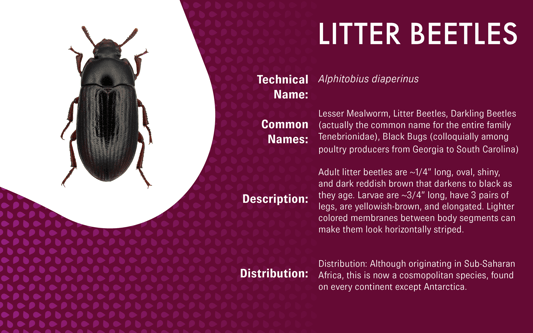A Closer Look with Danny McDonald, Ph.D.
 Litter beetles (Alphitobius diaperinus) are an invasive species of darkling beetle and are a stored product pest commonly found in poultry barns. Originally from sub-Saharan Africa, their prevalence in poultry barns is due to an abundance of poultry feed made up of their favorite grains and harborage with temperatures and humidity consistent with their ideal breeding conditions.
Litter beetles (Alphitobius diaperinus) are an invasive species of darkling beetle and are a stored product pest commonly found in poultry barns. Originally from sub-Saharan Africa, their prevalence in poultry barns is due to an abundance of poultry feed made up of their favorite grains and harborage with temperatures and humidity consistent with their ideal breeding conditions.
Litter beetles cause economical damage in poultry barns when consuming feed, spreading disease, causing damage to insulation, and negatively impacting feed conversion (rate of gain) if birds consume adult beetles and larvae rather than their nutritious feed. In fact, in a study by Grogan and Arrands (2008), they estimated that the return on investment of a good beetle control program, when only considering the cost of feed loss, was between $2,650 and $4,263 per 100,000 birds. This was when corn prices were between $2.00 and $4.50 per bushel.
They have a complete life cycle with egg, larvae, pupae and adult life stages. They complete their life cycle from egg to adult within 45–65 days and adult beetles can live up to a year (Geden and Axtel, 1987). They are highly fecund with each adult female laying up to 800 eggs in 42 days. Their population densities peak in mid-summer and decrease during winter months. Furthermore, adults can fly between barns an even between neighboring farms and are attracted to lights at night.
Litter beetles use aggregation pheromones for communication. Aggregation pheromones, produced by adult males, attract other adult males and females for mating purposes. They also utilize alarm pheromones to alert other members of their species of danger which causes them to move away from the pheromone.
There are many cultural changes in the poultry industry over the years. Some have had a positive impact on litter beetle management, but others have contributed to challenges with litter beetle management. On the positive side, 1) more broiler houses insecticide applications are being applied by a licensed professional, 2) integrators have become much better at understanding the importance of rotating between insecticide classes, and 3) insect growth regulators have become widely accepted as a necessary part of beetle management. However, chief among the negative changes has been a shift away from cleaning used litter out at least once per year, resulting in built up litter that provides perfect resources for beetles.
Follow CSI Production Animal on Twitter for upcoming product launches, product spotlights, and technical editorials such as "A Closer Look" with Dr. McDonald.
Danny McDonald, Ph.D. Tech Services Manager, Animal Health